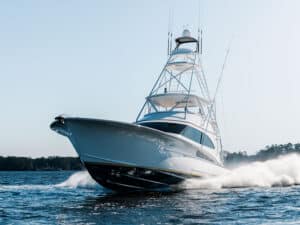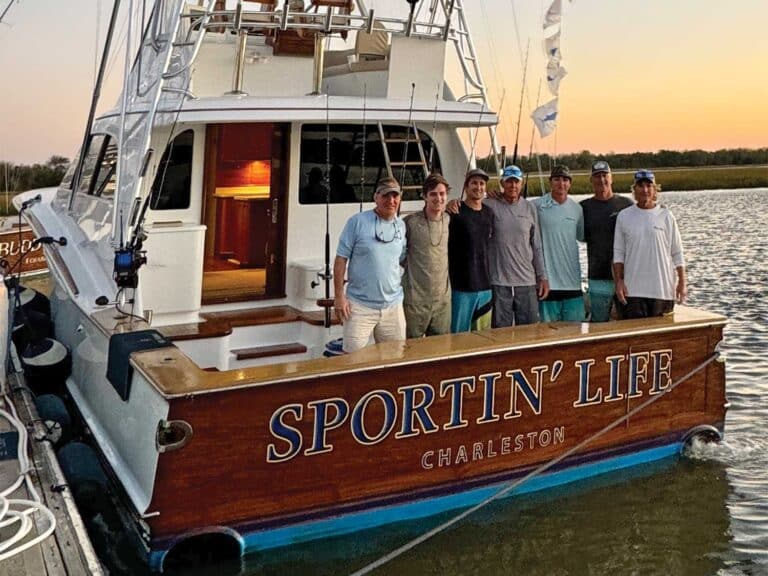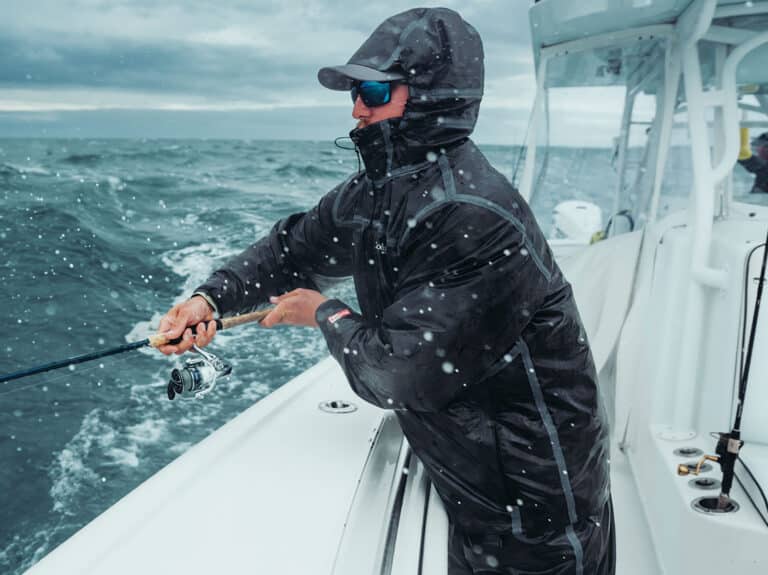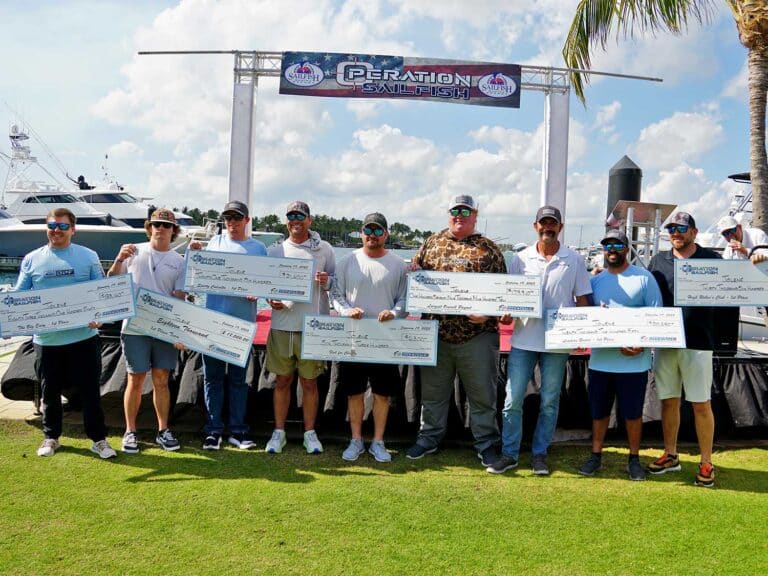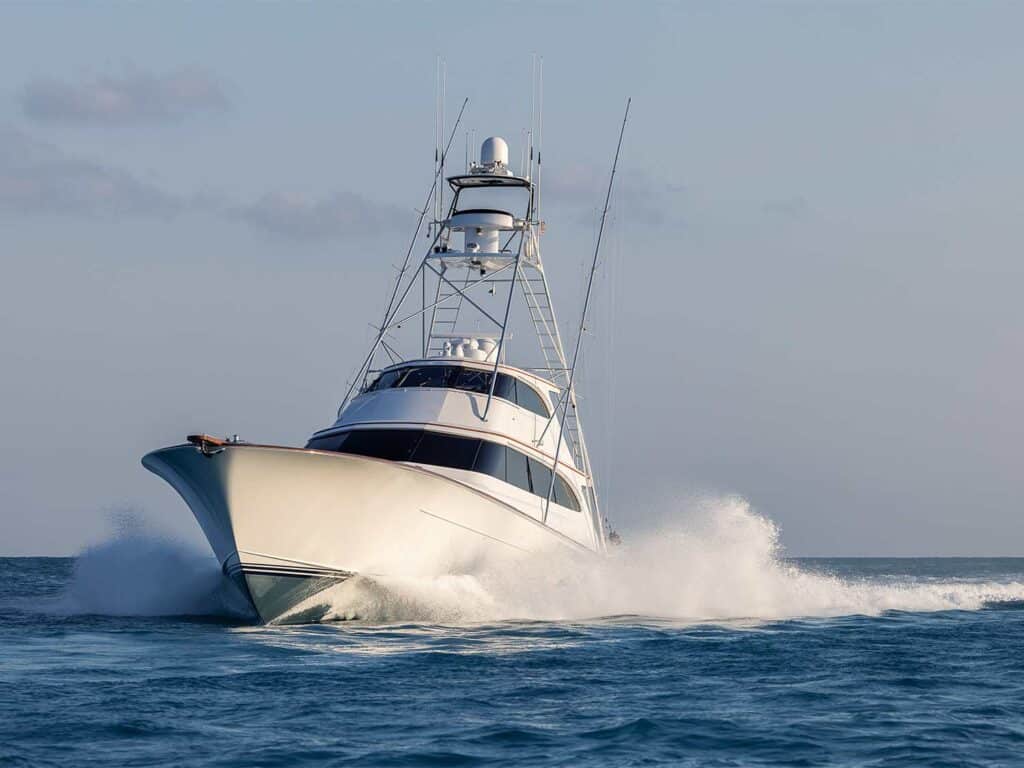
Special delivery: Sign up for the free Marlin email newsletter. Subscribe to Marlin magazine and get a year of highly collectible, keepsake editions – plus access to the digital edition and archives.
As I entered Ring Power’s swanky corporate boardroom, I immediately noticed a lineup of 10 thick photo albums spread across the glossy table. Some were full of black-and-white photographs and diplomas, the pages yellowed and faded. Others spilled over with colorful images that had been taken more recently in familiar destinations such as Bermuda and Costa Rica.
As I perused the chapters of his storied life, Randy Ringhaver, with a dapper black poodle proudly at his side, stepped in to greet me. Dressed in a navy suit and a coral tie dotted with sailfish, Ringhaver quietly welcomed me to Ring Power, the company he led as president and CEO for nearly two decades, and where he continues to serve as chairman.
In addition to his numerous professional achievements, Ringhaver has racked up a long line of personal titles, including husband, father, grandfather and serial boat owner. While his family remains his greatest love, Ringhaver’s fondness for boats swept into his life first. And, as with many good stories, it all begins in a busy boatyard.
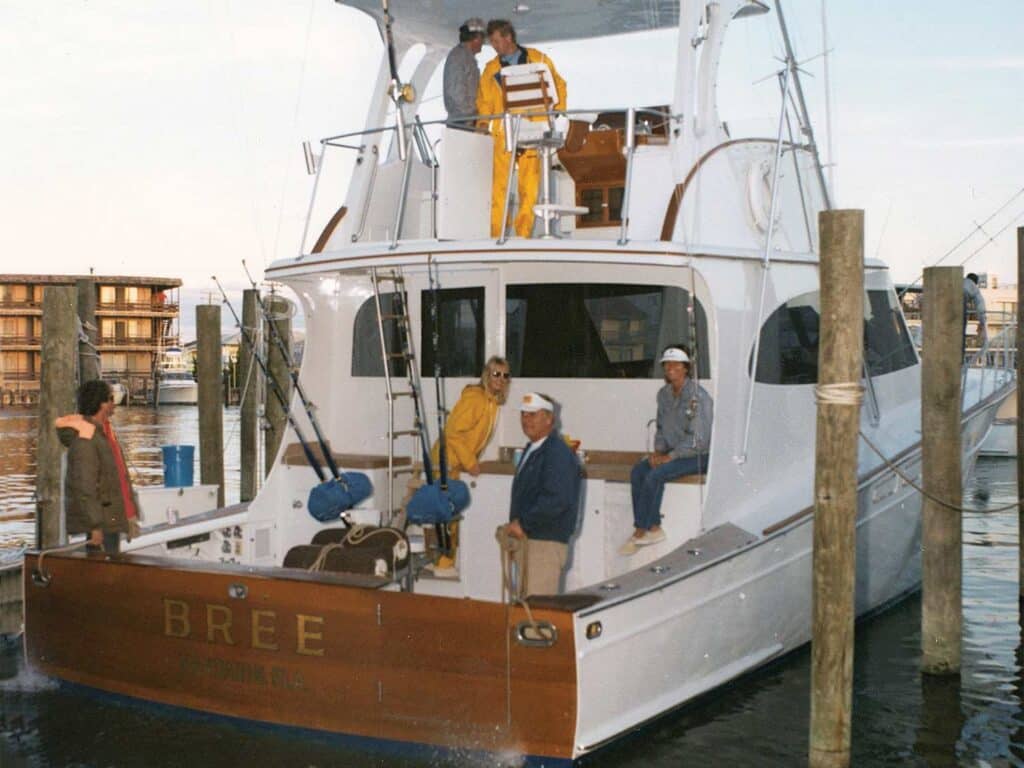
In the Yard
Ringhaver grew up in St. Augustine, Florida, in the 1950s at Diesel Engine Sales Co., a boatyard that specialized in building trawlers for the worldwide shrimp industry. His father, L.C. “Ring” Ringhaver, didn’t have any experience in boatbuilding when he initially took over the yard, but with his background working as an accountant at General Motors, Ring restructured the business in order to optimize efficiency. DESCO built one trawler per year when he first purchased the company; by 1952, DESCO was the largest builder of shrimp trawlers globally, turning out 100 boats per year.
“Everyone in the family—including mom in the early days—worked at the boatyard,” Ringhaver recalls. “You just can’t teach the experience and education gained from working alongside skilled craftsmen of all origins. The hulls, decks and pilothouses of our trawlers were all made in-house from various types of wood. Except for the engines, generators and electronics, the yard made everything.”
While the rest of the family just considered boatbuilding a living, Ringhaver saw the potential adventures a boat could offer. He saw a future. “For years we sold award-winning shrimp boats all over the world and adopted the slogan ‘The sun never sets on a DESCO trawler,’” Ringhaver says. “So when I learned in 1968 that we had sold the boatyard, I was devastated. I was a junior in college at the time, and my aspiration was to build boats after graduation. Needless to say, my experiences at DESCO were the foundation for my love of boats and boatbuilding.”
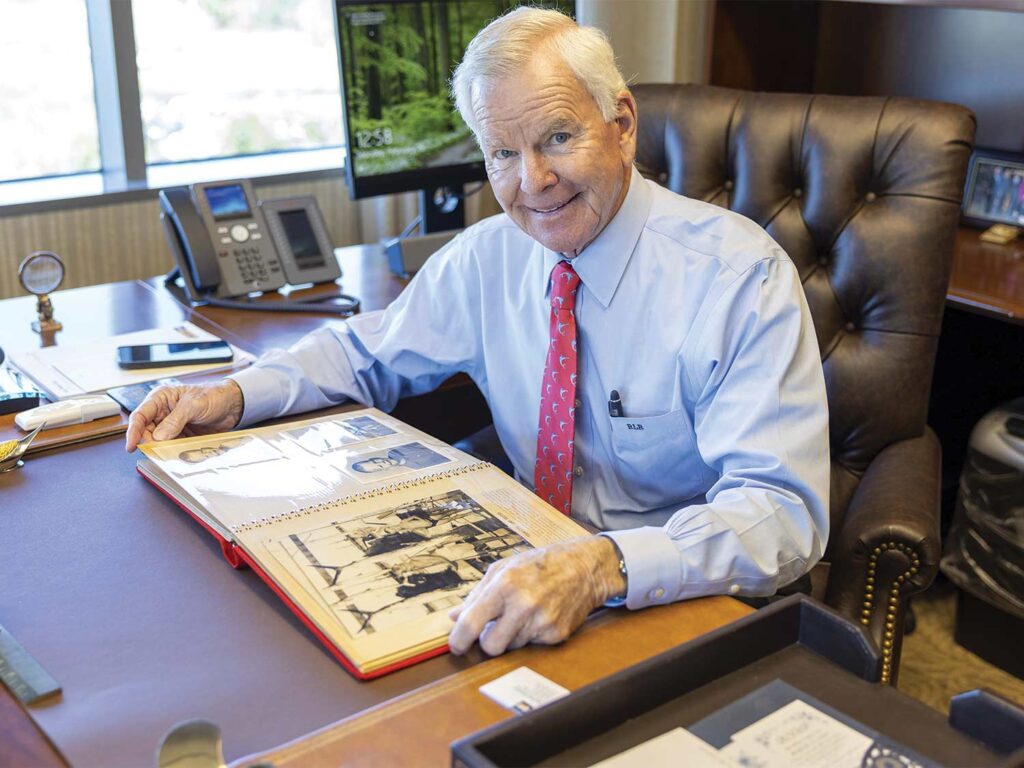
Ringhaver’s father always seemed to have a finger on the pulse of changing industries. He sold DESCO and exited the shrimp boat business just before shrimp farming emerged, which completely changed the supply chain. A few years before selling the boatyard, he negotiated a business deal with Caterpillar to install Cat marine engines in almost all of DESCO’s trawlers. The company eventually became Caterpillar’s single largest engine customer in Florida. Once he sold DESCO, it was no surprise that Ring would then move on to a new venture as a Caterpillar dealer, forming the first iteration of Ring Power Corp. Both of Ring’s sons would come to work for him at Ring Power and, upon their father’s death, would step into leadership roles.
Today, Ring Power is north and central Florida’s full-line Caterpillar dealership, offering heavy equipment, power systems, cranes and other Cat products for sale and rent. In addition to Ring Power’s 60 years of business with Caterpillar, the company has several projects in the works, including a relatively new partnership with Cox Diesel Outboards.
Ring Power also boasts a corporate sport-fishing program that has been entertaining customers for over 30 years, thanks to Ringhaver’s ability to strike a deal. “I was trying to get Luhrs—which was coincidentally located at the old DESCO yard—to use Cat marine engines in their sport-fishing models,” Ringhaver recalls. “They were using Cummins and were not going to change. So, in my meeting with them I offered to buy three boats if they would put Cat engines in their specification sheets. They bit, and I suddenly needed a captain to run a few boats. It was then we started the Ring Leader program.”
Ringhaver hired Capt. Greg Simmons to run the first Ring Leader, and he’s been with the program ever since. The current boat is a 65-foot express designed by Robert Ullberg and built in 2009 by Maine-based boatbuilder Lyman-Morris. With twin C32s, she’s a fast boat that also offers the best in guest entertainment. “In our industry, most people like to hunt and fish,” Ringhaver explains. “Having a customer group captivated in the cockpit for a day of fishing has a way of opening relationships that would be impossible with just a sales call. However, the wrong crew can make it a disaster. Capt. Greg and his crew are the best sales tool. They know what customers want before they even ask for it.”
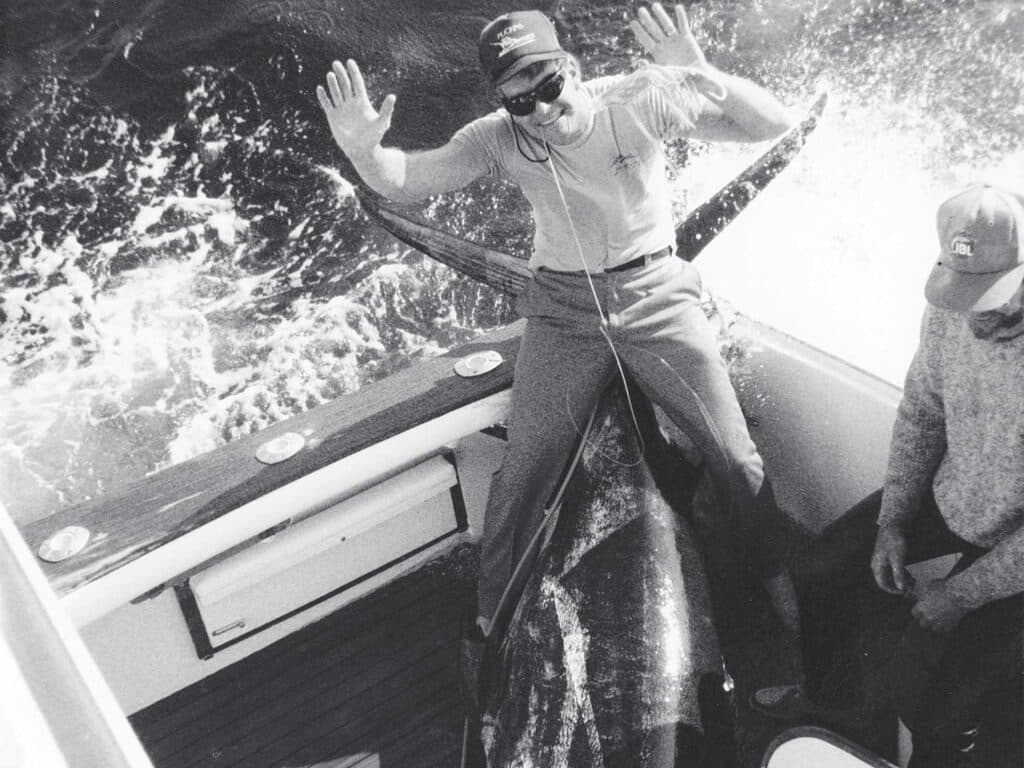
The First Bill
At 12 years old, Ringhaver was invited to fish off St. Augustine with the Kinsey family. It would be a day of firsts, as neither Cuda, the Kinseys’ 36-foot single-engine boat, nor Ringhaver had ever been offshore. “We needed to get up at 4:30 a.m. since Cuda was so slow, so I spent the night at the Kinsey house,” Ringhaver remembers. “Mr. Kinsey said he would be up early to look at the stars, and if it was clear, we would go fishing. I never slept, but instead stared out the window all night checking the stars. When we got up for breakfast, I was so nervous and excited that I couldn’t even eat.”
On the drive to the boat, Kinsey explained to the boys that he had top-secret bait for them to use that day. He swore them to confidentiality and unveiled a selection of ballyhoo. The Kinseys and Ringhaver would put those baits to work just hours later. “As the sun appeared on the eastern horizon, hundreds of kingfish were skyrocketing all around us, close enough to land in the boat,” Ringhaver recalls. “It didn’t take long for one to grab a ballyhoo. We caught two kingfish almost instantly.”
The bite then abruptly stopped for the crew aboard Cuda. Fifteen minutes passed without action. Suddenly a sailfish rushed in and ate a rigger bait. The younger Kinsey took to the rod and caught the fish. That sail was the first billfish Ringhaver had ever seen caught, but it wouldn’t even be the last or most meaningful of the day. The best was yet to come for the eager angler.
The group fished for another hour, until Kinsey explained that it was time to begin the long trek back to the dock. “I asked if I could leave a bait out on the slow troll home,” Ringhaver recalls with a boyish enthusiasm. “He agreed, and I sat alone in the cockpit, watching. Suddenly, a bill came out of nowhere, zigzagging behind the bait. I opened my mouth, but I couldn’t even speak. As I sputtered, Mr. Kinsey turned from the wheel, grabbed the rod out of the rod holder and handed it to me in the chair. I thought, ‘Game on!’ I was so afraid of losing my first crack at a sailfish that I think my adrenaline rush could have added five knots to the speed of the boat. I caught my first sailfish and officially graduated to offshore fishing that day. I’ve never looked back.”
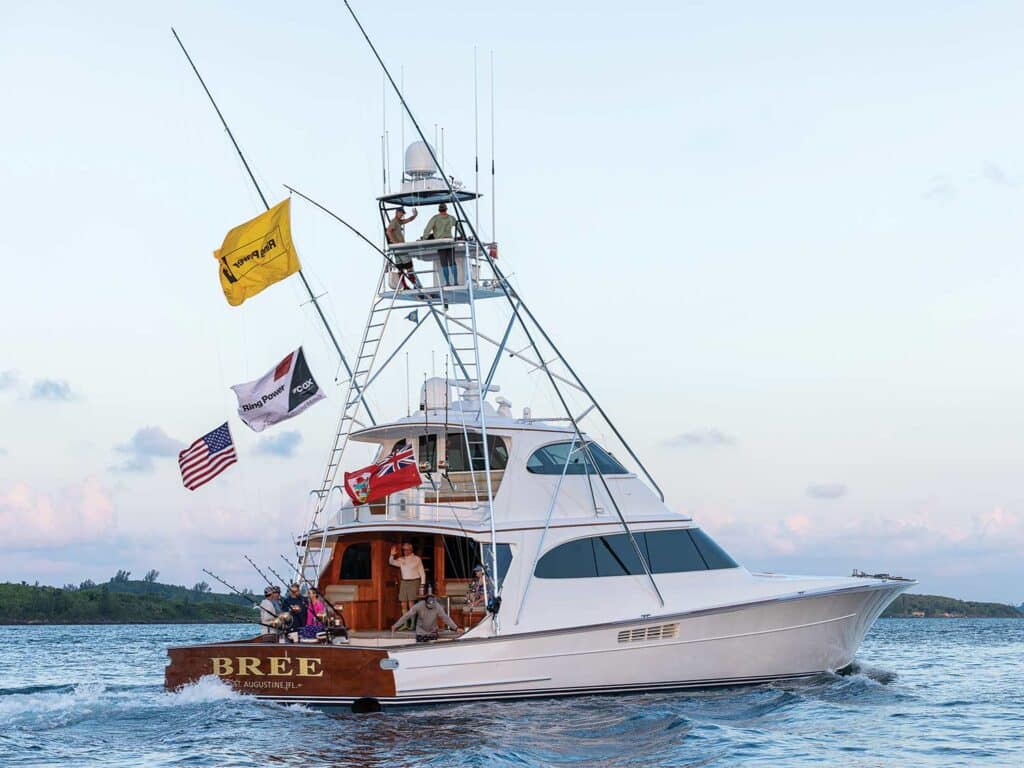
Bigger and Better Boats
Since that first crack at a sailfish, Ringhaver has owned several boats to help him in the chase. Although he now enjoys the capabilities of an 86-foot Merritt, as well as the luxury of a 150-foot mothership, his operation didn’t start with such grandeur. That said, even in the 1970s, Ringhaver prioritized the latest and greatest.
The first true offshore fishing boat that Ringhaver owned was Cool Cat, a 28-foot Bertram with gas engines. He fished it at home in St. Augustine and in the Bahamas for about a year, and then decided to size up to Cat Can, a 35-foot Bertram.
A man with understandable demands for horsepower, Ringhaver immediately modified the engines with dual turbochargers. Cat Can could run up to 20 knots when light on fuel, a fast clip at the time. Ringhaver experienced several exciting firsts on that boat, including the first swordfish bite off St. Augustine and his first blue marlin near Walker’s Cay in the Bahamas. He and his wife, Paula, had many special memories aboard that boat, including a trip that suddenly turned from a terribly stressful situation into one of the most welcome surprises of their lives.
“On one particular night in Walker’s, my wife became ill,” Ringhaver recalls. “I ran all the way back to West Palm Beach to get her to St. Mary’s Hospital. And bingo—it turned out Paula was pregnant, and I needed a bigger boat.”
As the Ringhavers welcomed their first child into their lives, work began on their next boat, a 51-foot custom Huckins. The build, Hull No. 425 for the Huckins brand and the first sport-fisherman the company had ever built, would be named after the couple’s newborn daughter. And thus began the Ringhavers’ recognized and beloved tradition of owning boats named Bree.

“Paula was heavily involved in all the interior on the Huckins, a critical role she has taken on for every build since then,” Ringhaver says. “We were able to put Cat 3406 engines in her and cruise at 27 knots. The first of the Bree boats fished locations from Atlantic City, New Jersey, all the way to Venezuela. We had so many great experiences over the 20 years we owned that boat, including the day we got to see Bree catch her first blue at Venezuela’s La Guaira Bank when she was 12 years old. One of the most special things we did on the Huckins was fish the International Billfish Series in the mid-1980s. We fished out of seven different locations for the tournament, including the Bahamas, Morehead City, Key West, Orange Beach, South Padre Island and West Palm Beach. Paula and I were the only husband-and-wife team entered, and we went on to win it all.”
Once Ringhaver decided to move on from the Huckins for more-advanced builds, he also opted to hire a full-time captain and crew. He’d been running his own boats for years, and the angler was finally ready to make his return to the cockpit. His friend Capt. Bill King suggested a boatbuilder located just a few hours south of St. Augustine: Merritt’s Boat & Engine Works in Pompano Beach, Florida.
With Capt. Rick Chapman set to take the helm, Ringhaver purchased Merritt Hull No. 77 in 1999, a 58-foot boat with Cat engines that had previously been known as My Lynn. “It was truly a step up for us and changed our ability to wander to places like Bermuda,” Ringhaver explains. That boat would be the first of five Merritt hulls—all of varying sizes, designs and systems—that the Ringhavers would own over the next 25 years.
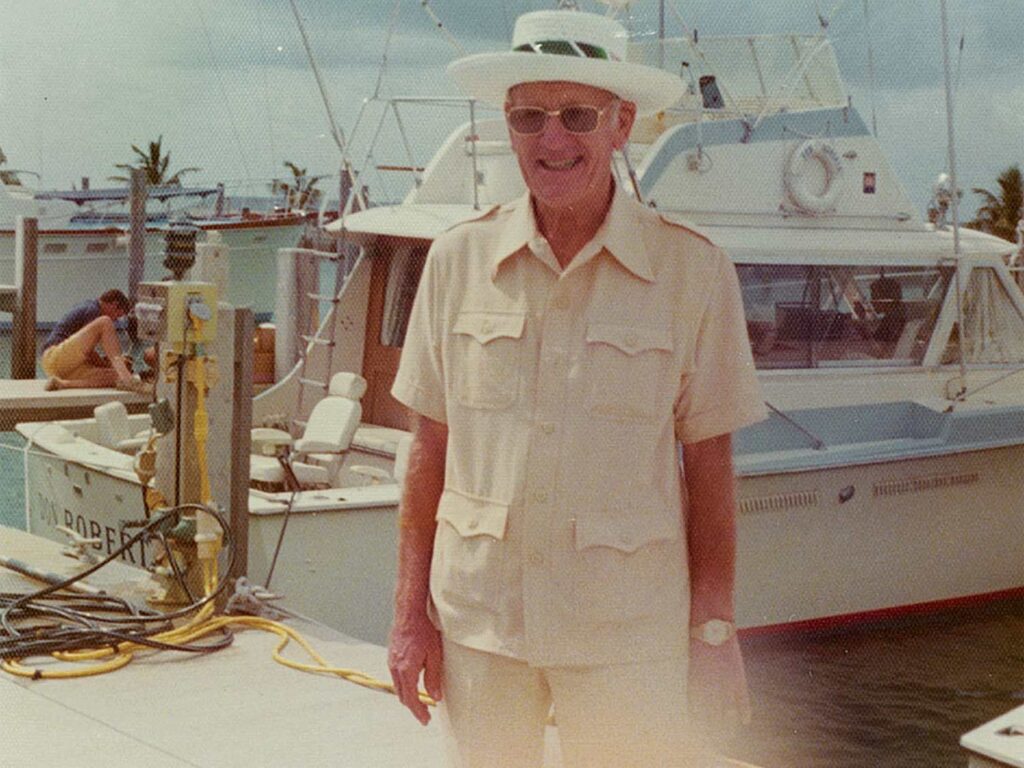
In that time, the Ringhavers have seen several captains and mates come and go through their outstanding program. Capt. Kyle Liane has been part of their Bree family for 17 of them now. He first came on board as a mate after meeting the family on the docks in the Dominican Republic. A few years in, he got the opportunity to take the helm.
Liane, along with mates Brent Huffman and Brian Jamison, keep the Ringhavers’ current 86-foot Merritt in great shape throughout the boat’s many travels, often alongside Bree’s mothership, Carson. The Ringhavers have a home in Chub Cay, so the program splits time among there, the Abacos, Bermuda, the Virgin Islands, West Palm Beach, Panama and Costa Rica. They often go wherever the fish are biting, and Ringhaver still proves to be a formidable adversary on the rod. “Randy is a top-notch fisherman,” Liane says. “He’s a very refined angler, whether he’s up against big blue marlin or bonefish. He proves that even with age, if you have good technique, you can conquer a beast in a battle.”
While Bree provides the family vibes, Ringhaver’s professional affiliations certainly offer up some nice perks of their own for the captain and crew. “Being a captain of a boat that is so closely affiliated with a Caterpillar dealership has been amazing,” Liane admits. “The support that our team gives us when it comes to maintenance and education is such an asset. Plus, Randy’s understanding of boats and what it takes to keep them running at the highest level is such a tremendous help. When big-ticket ideas come up, he knows why it’s so important to address them. But one thing is for sure: We always have to keep the engine room absolutely spotless.”

Roy Merritt, Ringhaver and Liane are currently working on their next build, an 88-foot sport-fisherman with an enclosed bridge and skybridge instead of a tower. The boat, which will have all the newest technological upgrades, as well as brand-new Cat 2, 400 hp engines, is scheduled to splash in late 2024. Ringhaver expects a fast, long-range vessel with plenty of space for his family and friends. Based on Ringhaver’s brief account of their relationship over the years, he and Merritt seem to be equally particular and unwavering, with a long-standing and mutual respect.
Read Next: Mothership Fishing Around the World.
Ringhaver radiates a calm, precise and steady confidence in his opinions and desires. Often motivated and inspired by emerging technologies and systems, he seems to chase the next best thing in boatbuilding with the same enthusiasm usually reserved for blue marlin. Perhaps that endless hunt is one of the main drivers for his outstanding business success as well as his impressive longevity as a serial boat owner. And still it seems that the mogul is far from finished.
As I closed his photo albums, thanked him for his time and gave his beloved poodle a farewell pat, a final adage Ringhaver shared with me that day echoed down the hallway through the closing elevator doors. I could almost see the subtle grin stretching across his face as I recalled his parting words: “Boats always need to be as long as you are old!” And so, the chase continues for Ring Power’s leading man.
